History
The church of Saint Bridget or Brigid is set in quiet countryside, adjoining the site of a deserted medieval village. [1] It was traditionally founded by Brochwael, the son of Meurig of Gwent, in the 10th century. [2] The church tower dates from the 13th or 14th century, but the body of the church was rebuilt in the 19th century after it became dilapidated. [3]
The parish was part of the medieval lordship of Striguil. It is so named to distinguish it from the village of St Brides Wentloog, to the west of Newport. "Netherwent" is the English name given from the Norman period onwards to the Welsh cantref of Gwent-is-coed (Gwent beneath the wood, i.e. Wentwood), with "-went" deriving from the Roman town of Venta which became Caerwent.
Aside from today's farmhouses outlying the clustered centre, St Brides Netherwent was abandoned in the 18th century. [3]

Monmouthshire is a county in the south east of Wales. It borders Powys to the north; the English counties of Herefordshire and Gloucestershire to the north and east; the Severn Estuary to the south, and Torfaen, Newport and Blaenau Gwent to the west. The largest town is Abergavenny, and the administrative centre is Usk.
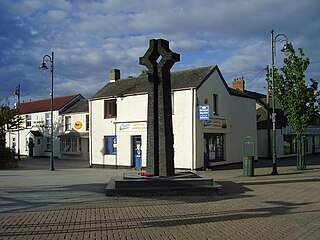
Caldicot is a market town and community in Monmouthshire, Wales. The town is located between Chepstow and the city of Newport. The site adjoins the Caldicot Levels, on the north side of the Severn Estuary. The population of the built-up area was around 11,000. It has a large school, Caldicot School, and is known for its medieval castle. The built-up area includes Portskewett. Caldicot had a population of 9,604 in 2011.

Caerwent is a village and community in Monmouthshire, Wales. It is located about five miles west of Chepstow and 11 miles east of Newport. It was founded by the Romans as the market town of Venta Silurum, an important settlement of the Brythonic Silures tribe. The modern village is built around the Roman ruins, which are some of the best-preserved in Europe. It remained prominent through the Roman era and Early Middle Ages as the site of a road crossing between several important civic centres. The community includes Llanvair Discoed. The village itself had a population of about 1,200.

Rogiet is a small village and community in Monmouthshire, south east Wales, between Caldicot and Magor, 8 miles (13 km) west of Chepstow and 11 miles (18 km) east of Newport, which covers an area of 847 hectares (3.27 sq mi). It lies close to the M4 and M48 motorways, and the Second Severn Crossing. It has a railway station named Severn Tunnel Junction. Rogiet only has a population of 1,813 (2011).

Magor is a large village in Monmouthshire, south east Wales, about 9 miles (14 km) west of Chepstow and about 9 miles (14 km) east of Newport. It lies on the Caldicot Levels beside the Severn Estuary, and is in the community of Magor with Undy. Magor lies close to the M4 motorway.

Caldicot was an ancient hundred of Monmouthshire, Wales.
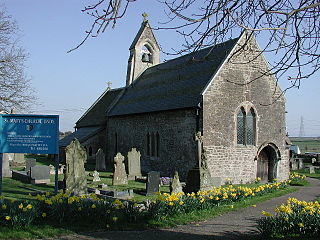
Undy is a village in Monmouthshire, south east Wales, adjoining the village of Magor with which it forms the community and parish of Magor with Undy. It is located about 3 miles (4.8 km) west of Caldicot and 10 miles (16 km) east of Newport, close to the junction of the M4 and M48 motorways, and adjoins the Caldicot Levels on the north bank of the Bristol Channel.

Wilcrick is a hamlet within the administrative boundary of the city of Newport, South Wales, just to the west of Magor and approximately 7 miles (11 km) southeast of Newport city centre. It is within the historic county of Monmouthshire.
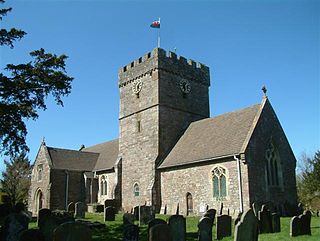
Shirenewton is a village and community in Monmouthshire, south east Wales. It is located 3 miles due west of Chepstow, 5 miles (8 km) by road. The village stands around 500 feet above sea level, and has extensive views of the Severn Estuary and Bristol Channel. The population of the village and the conjoined village of Mynydd-bach was 657 in 2011.

Llanvair Discoed is a small village in Monmouthshire, south-east Wales, 6 miles west of Chepstow and 10 miles east of Newport.
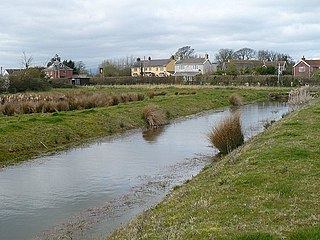
Goldcliff is a village, parish and community to the south east of the city of Newport in South Wales. It lies within the Newport city boundaries in the historic county of Monmouthshire and the preserved county of Gwent. Administratively, the community of Goldcliff includes the village/parish of Whitson. The population in 2001 was 233; by 2011 it had risen to 329.

Redwick is a small village and community (parish) to the south east of the city of Newport, in Wales, United Kingdom. It lies within the Newport city boundaries, in the historic county of Monmouthshire and the preserved county of Gwent. In 2011 the population was 206.

Gwent was a medieval Welsh kingdom, lying between the Rivers Wye and Usk. It existed from the end of Roman rule in Britain in about the 5th century until the Norman invasion of Wales in the 11th century. Along with its neighbour Glywyssing, it seems to have had a great deal of cultural continuity with the earlier Silures, keeping their own courts and diocese separate from the rest of Wales until their conquest by Gruffydd ap Llywelyn. Although it recovered its independence after his death in 1063, Gwent was the first of the Welsh kingdoms to be overrun following the Norman conquest.
Southern Monmouthshire was a parliamentary constituency in Monmouthshire, Wales. It returned one Member of Parliament (MP) to the House of Commons of the Parliament of the United Kingdom.

Portskewett is a village and community (parish) in Monmouthshire, south east Wales. It is located four miles south west of Chepstow and one mile east of Caldicot, in an archaeologically sensitive part of the Caldicot Levels on the Welsh shore of the Severn Estuary. The Second Severn Crossing passes overhead carrying the M4 motorway. The community includes Sudbrook, Crick and Leechpool.

Sudbrook is a village in Monmouthshire, south east Wales. It is located 4 miles south west of Chepstow and 1 mile east of Caldicot. It lies close to the Second Severn Crossing on the Severn Estuary, and adjoins the village of Portskewett. It was largely built in the late 19th century for workers on the Severn railway tunnel. At that time it was also known as Southbrook.
Gwent Wildlife Trust (GWT) is a wildlife trust covering the area between the lower Wye and Rhymney rivers which forms the vice county of Monmouthshire in south-east Wales. It is a registered charity and a member of the Wildlife Trusts Partnership.

The Church of St Mary stands in the centre of the village of Magor, Monmouthshire, Wales. It was designated a Grade I listed building in 1963. The church is the lead church of the Netherwent Ministry Area, led by Rev. Canon Jeremy Harris, and administers to a population of around 32,000.
Saint Tathyw was a 5th-century saint of South Wales, and founder of a monastic school at Caerwent where he instructed many of the leading figures of the early Welsh church.
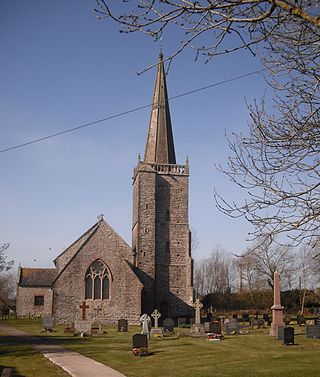
The Church of St Mary the Virgin, Nash is the parish church of the village of Nash, situated about 2 miles (3.2 km) south of the city of Newport, Wales. Described as "the cathedral of the moors" by Monmouthshire historian Fred Hando, the large church is medieval in origin, with additions and restorations dating from the 18th and 19th centuries. Newman describes the 15th-century steeple as "unique in South East Wales". Since 3 January 1963 it has been designated a Grade I listed building primarily due to its "medieval tower with fine spire."

















